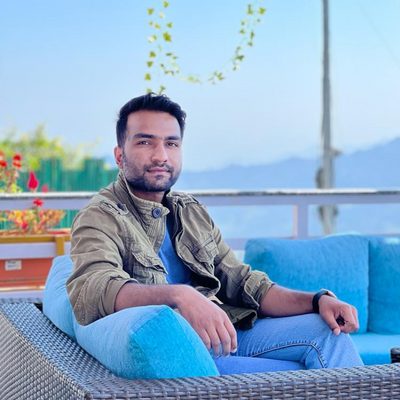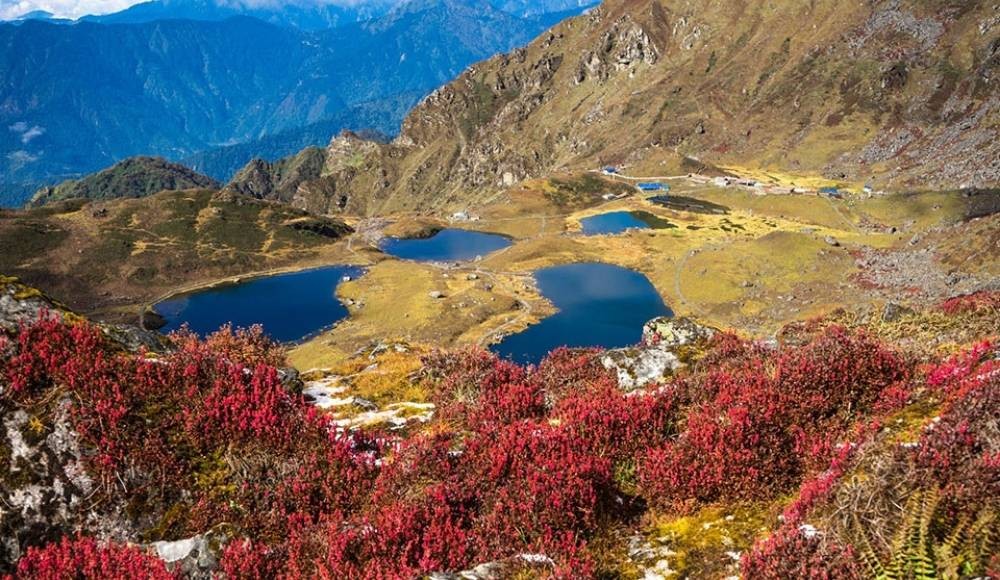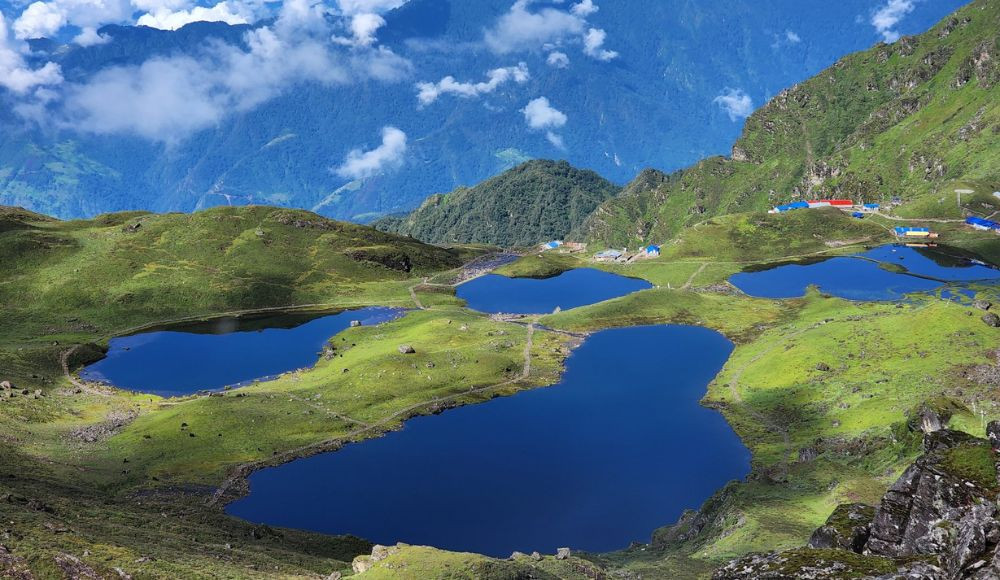Panch Pokhari Sindhupalchowk
Panch Pokhari is one of the main features of Langtang National park, located in the Nuwakot, Rasuwa and Sindhuplachowk districts of the central Himalayan region.
Panch Pokhari is one of the main features of Langtang National park, located in the Nuwakot, Rasuwa and Sindhuplachowk districts of the central Himalayan region.


Panch Pokhari is an association of five Hindu holy lakes which lies in the Sindhupalchowk District in Nepal. It is the 9th altitude wetland in the world. The lake is a popular destination for Hindu and Buddhist pilgrims. Panch Pokhari is a relatively unexplored, pristine and best-kept secret of nature. It has amazing beauty and moreover, inexplicable sceneries. The splendid mountain panorama and very pristine natural beauty along with the incredible wetland attractions and flora and fauna make this a must-visit place in the remote mountain land of Nepal.
Panch Pokhari is one of the main features of Langtang National park, located in the Nuwakot, Rasuwa and Sindhuplachowk districts of the central Himalayan region. The government of Nepal’s Postal Series Department issued a stamp featuring Pokhari in 2011. Panch Pokhara is situated at an elevation of about 4100m above sea level. This is also a famous Hindu pilgrimage site in Nepal.
Panch Pokhari trekking lies to the north of the Kathmandu valley. The chain called Jugal Himal includes Dorje Lakpa, Madiya, and Phurbi Chhyachu. Through the trek, you will get to experience traditional Tamang and Sherpa culture as well. Also, for those visitors who are looking for a spiritual, peaceful, and beautiful trek, this camping trek is an ideal one.
In the hustling and bustling lifestyle of Urban cities, who doesn’t want to get away to have an incredible escapade into nature! Panch Pokhari is one of the most beautiful places in the world. The mind-blowing sceneries of the settlement and the lake system of Sindhupalchowk are the most beautiful things to explore.
|
Location |
Bhotang, Sindhupalchowk |
|
Accommodation |
camping |
|
Best months to visit |
April, May, September, October, November. |
|
Altitude |
4100 m. ASL |
|
Trekking duration |
6 to 14 days depending upon the itinerary |
|
Culture |
Newar, Brahmin, Chhetri, Gurung |
|
Himalayan sights |
Gauri Shankar, Dorje Lakpa, jugal Himalayan range, Rolwaling Himalayan range etc. |
|
Geography |
Countryside, forest, mid-hills, glaciers, mountains, rivers, cold places, valleys, villages, etc. |
The Panch Pokhari trail is a newly introduced trekking area in Nepal. Panch Pokhari (4,100 m) is located northeast of Kathmandu at the base of the Jugal Himal. This place has cultural, religious, and ecological importance as well. An important festival, the Janai Purnima festival, is held here every year in August. People of Brahmin castes come here for the ritual of changing the sacred thread (Janai) they wear around their bodies.
Thus, the five ponds (Panch Pokhari) here are regarded as sacred ponds. Situated at the base of the Jugal Himal, the ecology is pretty diverse and of significant importance. The trek takes you through Sherpa and Tamang villages, so it’s something of a Nepal cultural trek.
Panch Pokhari is full of adventure and mysteries. The geographical terrains, flora and fauna, and the mountain vistas are best explored here. There are a lot of things to do in Panch Pokhari. From exploring nature to worshipping the lakes and rejoicing in the spiritual atmosphere, every possible thing has a sort of experience to offer.
Panch Pokhari trekking is a non-tourist trekking trail in Nepal. This ( five lakes)trekking offers beautiful Himalayan views including the Gauri Shanker, Dorje Lakpa, Langtang Himalaya range, Jugal Himalayan range, Rolwaling Himalayan range, Tibetan Himalayan range, etc and also the pristine nature with district culture. Also, the Panch Pokhari stands for 5 holy ponds and Hindus religiously respect the place.
Yoga is a universal concept that brings scattered things together. It has been traditionally practised for thousands of years in the Himalaya regions. The Yoga that we have today has been innovated by Lord Shiva, Lord Budhha, great sage Patanjali and Yogis. Mediation is a must-do activity in our daily lives. It gives us calmness, peace of mind and a sense of well-being. It also helps us to have better relationships, better health, and a better life.
Nepal is one of the best places in the world to practice Yoga and Meditation. It has many beautiful scenic places where tourists can practise yoga and meditation themselves. Nowadays Many institutes are also offering yoga and meditation classes in a clean, peaceful and astounding environment.
Camping is an outdoor activity involving overnight stays away from home in a shelter, such as a tent. Typically participants leave developed areas to spend time outdoors in more natural ones in pursuit of activities providing them enjoyment. To be regarded as ‘camping’ is a minimum of one-night activity spent outside, separating it from day-tripping, quick cinch camp, and other similar short term activities. The camping can be enjoyed throughout all four seasons.
Panch Pokhari camping trek through untouched traditional villages in spectacular Himalayan landscapes. Ultimate trekking experience in an off-the-beaten-path through untouched wilderness and unspoiled settlements in the mountain of Nepal.
This trek to Panch Pokhari at the base of Jugal Himal also offers pristine mountain views, rich culture, and genuine adventure. This spectacular region certainly offers a combination of rich cultural heritage, unsurpassed beauty, and biological diversity as you trek to a group of high altitude holy lakes, sacred to Buddhist and Hindu people.
Sightseeing in Nepal is a popular activity. Nepal is one of the best countries for sightseeing, with its long history, fascinating art, and distinctive and varied architecture. The sights in the Panch Pokhari are something you’d never be fed of. Moreover, the very beautiful views of Dorje Lakpa, Phurbu Chhyachu, Madiya, Jugal Himal, Rolwaling and Langtang range can be seen from Panch Pokhari.
Every year, on the occasion of Janai Purnima, hundreds of pilgrims from around the country pay a visit to the ponds. The festival of Janai Purnima usually falls in August. It is the festival when the Brahmin people of Nepal change their Janai, which they wear around the body. They go to the Panch Pokhari, take a bath in ponds and also they change their Janai. As the ponds are situated in the shadow zone of the Jugal Himal, the ecological system is of diverse nature. So, it adds more reason to go camping as it promotes green tourism.
Panch Pokhari is an incredible destination that is composed of five beautiful lakes. The lakes are considered to be the origin of the Indravati River. The importance of Panch Pokhari is mentioned in the Panch Pokhari Mahatmyam, Skanda Purana, Himwat Khand. It states that the Bhairav Kunda, Saraswati Kunda, Surya Kunda and Nag Kunda are said to be the places of equivalent significance as pilgrimage places of Tirthraj Prayag and Badganga Kurukshetra.
According to the five Tibetan scriptures, the Hyolmo region of Helambu, where the Gupta Mantra tantra Nidhi is believed to be hidden, is considered to be the Tapobhumi and the mystery of Tantra mantra Siddhi. From Param Guru Rinpoche (Padmasambhava), Mahayogi Milarepa, Ama Yangri to Ananta Autari Lama Guru is believed to have meditated in this pristine foundation.

A lot of domestic tourists and visitors embark on their journey to the five ponds that hold a grand fair targeting Ekadashi and Janai Purnima.
The glowing Sapphire in the lake, bright and vibrant mountains and the mountain range and the sky are incredible at this place. A series of clouds covering the captivating snow-capped peaks around the five transparent pristine lakes is the best thing to witness at this mind-blowing destination in Nepal.
This place is so splendid that one can imagine the Vibhuti Jugal, the king of white snow; Lakpa Dorje, the head of the five ponds; and Simi Sidang, the god of Hyolmo of Helambu, beholding the ponds. At the elevation of 4200 m above sea level, everyone who gets a sight of this settlement of nature would believe it to be heaven on earth for real.
According to legend, the Panchpokhari area is considered as the abode of Lord Shiva Parvati and all the five ponds are considered as their daughter. From the right, the names of the ponds are also put as Jethi, Mahili, Sahili, Kaili and Kanchi Pokhari respectively. This incredible creation of nature is only seen in Nepal. And the perfect blend of this religious and natural significance made it a perfect place to explore.
Panch Pokhari can be reached via two trails. One trekking starts from Sano Okhareni via Chautara and another starts from Bhotang via Melamchi. The Bhotang is the easiest and most preferred route to trek in Panch Pokhari.
The trek starts from Bhotang after reaching there via a drive from Kathmandu. Amazing settlements of cultural groups, natural sceneries, beautiful vistas, flora and faunas etc. are the major things to explore during your drive to Bhotang. The trek further from Bhotang will take you to Deurali and ahead to Nasempati. The beautiful valleys, cross country rivers and water streams are the major attractions along the way. Moving forward to Laure Bhanjyang, you can see the beautiful terraced farmlands and flora and fauna. Laure Bhanjyang is also the last place of stay before reaching Panch Pokhari.
You will visit Panch Pokhari and explore the incredible beauty of the wetland. Afterwards, you will return to Tangu and trek to Bhotang. From Bhotang you can get a returning drive to Kathmandu via Melamchi.
Panch Pokhari trek enables you to explore the beauty of the countryside in the mountain wetlands of Nepal. The beautiful scenery, cultural villages, rivers, valleys and remote atmosphere are the major attractions of the trek. Alongside, you can also explore the sweeping beauty of mountain panorama and a diverse range of flora and fauna.
This trekking area is diverse as you can explore the beauty of mountains, wetlands, flora and fauna, remote settlement and cultural habitats. A mix of various experiences perfectly blends in the Panch Pokhari trek.
10 hours of the Bus ride and more than 2 hours of walking: Kathmandu- Dhulikhel- Zero Kilo- Melamchi route to Kathmandu- Sankhu- Melamchi route as it is comparatively less bumpy and riskier but longer. The drive from Kathmandu will take you to Melamchi and the drive further takes you to Bhotang. A little trek ahead, you will be in Deurali.
The scenery was eye-catching and you could see the beautiful mountain range and rocky hills. After sipping the warm tea in Nashimpati, carrying on your walk with various speculations and excitements of Panch Pokhari, you will move forward. Also, the spectacular sunset and view around us were offering us some kind of power to endure. (around 10 hours of walking)
Picturesque beauty as seen from Laure Bhanjhyang. At Panch Pokhari, there is a temple and a couple of rest-houses for travellers but no one lives there. You may explore the beauty along the trail. Beautiful villages, the local lifestyle, culture and traditions along with the natural settlement is mind-blowing.
Fresh air drifting, birds singing the exhilarating melodies, bells hung in the animals ringing all of them creating a happy moment. You may choose to go to Chautara via jeep. From Melamchi, you may have a drive to Kathmandu.
Panch Pokhari trek is a moderately difficult trek in the Langtang Helambu region. This area is relatively unexplored and less visited. So, visiting this region is rewarding in terms of the experience you get. This area is uninhabited, so it is certainly difficult in terms of proper accommodation facilities. There are a few teahouses in the lower parts. However, you might have to camp in the higher elevations. The most beautiful part of trekking is you can experience the very remote and rural atmosphere in the amazing landscapes of Nepal.
This trekking area lies at an elevation above 4000 m. So, there are chances of getting altitude sickness. The proper medication and other precautions can help mitigate the risk of severe Acute Mountain Sickness. Therefore, before trekking in this region, understanding altitude sickness is important.
The winter and summer time are not recommended to trek in this region. Trekking during the months of monsoon and summer exposes you to geographical risk. During the monsoon season, the mountain terrains are prone to avalanches and landslides. So, it is best avoided. Also, you won’t certainly like the leeches and earthworms along the trails. The uncertain weather and climatic conditions in summer make it unfavourable to visit mountain areas.
Winter is a wonderful time to explore new places. However, the snowfall and frosty cold in the higher elevations and not so open sky make it quite unfavourable. Also, there are chances of losing the trekking trail as the atmosphere might be gloomy and snowy. This can be harsh. So, it is best avoided to trek during monsoon and winter.
The most popular seasons for Panch Pokhari are the seasons of spring and autumn. Autumn falls in the months of September, October, and November. Spring falls in the months of March, April, and May. Moreover, a moderate amount of sunshine and a low amount of precipitation are some of the reasons why these seasons are popular for completing this trek.
The views of the mountains are also gorgeous. You can also complete Panch Pokhari in the winters (December, January, February). You have to have the appropriate gear to deal with the cold and snow in this season though. With appropriate gear and planning, you can also complete Panch Pokhari in the summer (June, July, August) season.
During the Spring and Autumn Season, the weather is pleasant and stable. So, visiting this time has better chances to make the experience better. It is highly recommended to check the weather forecast before braving the journey to this mind-blowing destination in the Sindhupalchowk district of Nepal.
Panch Pokhari is considered as a moderate difficult trek, its highest elevation is 4100m above the sea level.
The trekking in this area is very wonderful. The splendid experience you get is the most beautiful part of trekking in this area. Besides, sightseeing, exploring nature and culture, witnessing the incredible mountain vistas, and the wetlands of Panch Pokhari are the major things to explore in this area. It is also a perfect spot for Yoga and Spirituality, Photography and Dispersed Camping.
The best time to visit the Panch Pokhari trek is during the Spring and Autumn Season in Nepal. Spring lies in the months of March until May and Autumn lasts till September to November.
To complete the trek, you need 5-10 days. Trekking depends on the walking speed and the route you take to reach there. So, depending on the walking speed and route, the trek can take anywhere between 5 to 10 days.